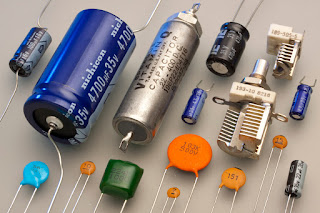 |
| Different types of Capacitor Photo Credit - www.wikipedia.org |
A capacitor stores electrical energy by electrostatic stress in the dielectric.it consist of two conducting surfaces separated by a layer of an insulating medium which is called dielectric.the conducting surface may be in form of either circular plates or be of spherical or cylindrical shape.
Capacitance - Capacitance is the property of capacitor to store electricity.the capacitance of a capacitor is defined as the amount of charge required to create a unit potential difference between its plates.due its property of storing electricity (charge),capacitor is called a storing element.If a charge of Q coulomb is given to one of the two plate of capacitor and if a potential difference of V volts is established between the two ,then its capacitance is
C = Q/V = Charge/Potential difference
Capacitance is the charge required per unit potential difference. The unit of capacitance is coulomb/volt which is also called farad.
1 farad =1 coulomb/volt
One farad is defined as the capacitance of a capacitor which required a charge of one coulomb to establish a potential difference of one volt between its poles.The characteristic of nearly all physical capacitors is monotonically increasing that, as v increases Q increases.
 |
| Characteristic of physical capacitor |
In the circuit diagrams a capacitor is represented symbolically as shown in figure below,
 |
| Symbol of capacitor |
When i(t) is positive, positive charges are brought (at time t) to the top plate whose charge is Q. The rate of change of Q is also positive. Thus we have,
i(t) = dQ/dt
Current - voltage relationship in capacitor
The charge on a capacitor is given by the expression
Q = Cv
Putting this value in the above equation of i(t) we get,
From the above equation following important parameters are found:
- Since Q = Cv, the voltage across a capacitor is directly proportional to charge Q where C is capacitance/proportionality constant.
- A capacitor has the property of causality.
- Current in the capacitor is present only when voltage on it changes with time that is, AC Voltage. When its voltage is constant or DC voltage, i(t) = 0. Hence the capacitor behaves like open circuit.
- Rate of change in voltage of a capacitor is inversely proportional to its capacitance.
- Rate of change in capacitor voltage is slower when the value of capacitance C is high. Also the capacitor does not accommodate the change in current instantaneously.
In this way the introduction of capacitor is given briefly. We will also update more details of capacitor including its charging, discharging, types etc in upcoming posts.






I just google great article about tunnel diode, if sb need more information about Tunnel Diode you can check this article. In this article you can get know about tunnel diode characteristic, symbol and basics definition.
ReplyDelete